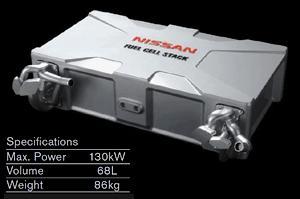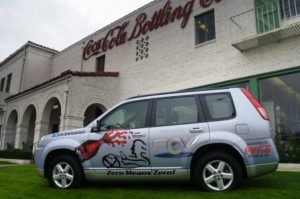Nissan North America today announced the lease of an X-Trail fuel cell vehicle to Sacramento Coca-Cola Bottling Company.
This is Nissan’s first commercial FCV lease in North America, and it’s for one year, with an option for two additional years at an undisclosed rate.
The vehicle is based on the X-Trail sport utility, which is available in Mexico, Japan and Europe. It has a Nissan-developed fuel cell stack, lithium-ion batteries and a high-pressure hydrogen storage cylinder.
Performance is said to be close to that of a similarly sized internal combustion engine-based vehicle. Versions of this generation are capable of speeds in excess of 95 miles per hour, with a cruising range of up to 300 miles, according to Nissan.
Nissan has previously used FCVs in demonstration fleets in Japan and in California through the California Fuel Cell Partnership (CaFCP).
“Sacramento already has the beginning of a hydrogen infrastructure in place, and Sacramento Coca-Cola has a track record of utilizing low emissions cars, so the two companies share a green philosophy as well as a common love of things ‘zero’,” said Eric Nozier, vice president, Corporate Planning, NNA.
The fuel cell vehicle will be used by the bottler for sales calls and public events promoting its Coca-Cola Zero soft drink.
“This is a big step in furthering our commitment to environmental sustainability,” said Bob Brown, executive vice president of Sacramento Coca-Cola.
The Nissan fuel cell efforts in the U.S. appear relatively modest if compared to General Motors attempts to commercialize fuel cell cars.
Chevrolet Equinox fuel-cell electric vehicles have passed one million miles of testing. There are currently more than 100 of the electric vehicles on the road, which GM claims is the largest consumer fuel cell demonstration fleet in the world.

Electricity made by current fuel cells is $73 a kilowatt. Typically, a kilowatt of for residential use costs 15 cents.
Sacramento-based X-Trail FCVs have logged 300,000 miles in ongoing internal tests, with one vehicle approaching 100,000 miles.
Nissan says it will have a commercial fuel cell vehicle on the market by the second half of this decade.
The on-board fuel cell stack in FCVs that generates electricity is similar to ones used by the U.S. space program, and thus far almost as expensive.
The Department of Energy estimated last year that in volume production electricity would be made by current fuel cells at $73 a kilowatt. Typically, a kilowatt of electricity for residential customers costs 15 cents or less.
In spite of the enormous technical challenge, the attraction of fuel cells is that the only emissions created are water vapor — if you don’t take into account how the hydrogen fuel is created that is used in the cell.
In the U.S., almost half of the electricity generated comes from burning coal, a relatively dirty fuel that generates large amounts of carbon dioxide, among other pollutants.

